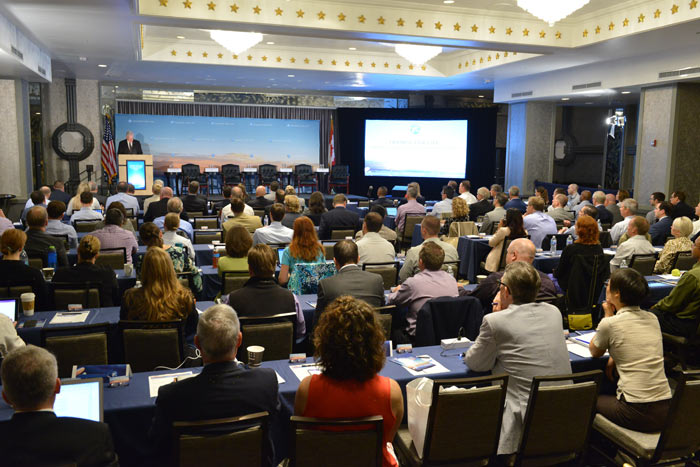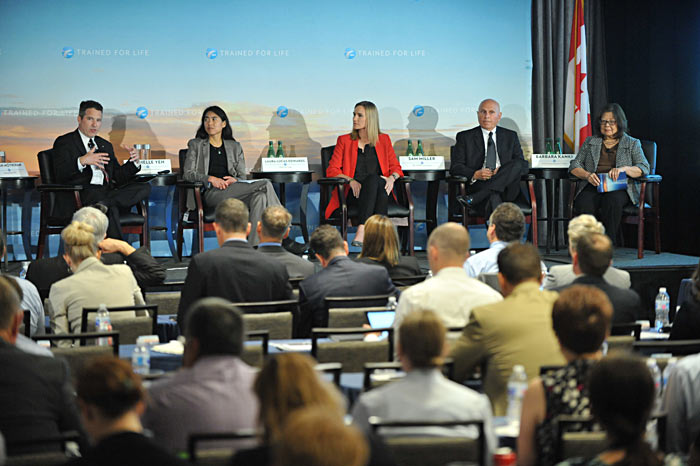Trained for Life: Keeping Humans at the Center of Aviation
By Christopher Freeze, Senior Aviation Technical Writer

More than 125 participants attend ALPA’s recent “Trained for Life:Human-Centered Approach to Safety” Symposium in Washington, D.C.
“No technology or material can currently perform like the most important safety asset on every passenger or cargo airliner: an adequately rested, fully qualified, and well-trained pilot and copilot. And I do mean two pilots in the cockpit,” said Capt. Tim Canoll, ALPA’s president, during his opening remarks at ALPA’s “Trained for Life: Human-Centered Approach to Safety” Symposium held in Washington, D.C., on May 31.
“Ensuring that human factors are at the forefront of aircraft design, procedures development, and training is necessary to the continued safety of our industry,” Canoll noted.
Citing ALPA’s leadership in human factors, the Honorable Robert Sumwalt, National Transportation Safety Board chair and a former ALPA member, reflected on the past two decades of related industry advancements and the board’s role in investigating and studying system safety. “If you don’t account for human error, you, yourself, have made a very basic human error,” he stated before highlighting several accident investigations in which human factors played a role.
Bobbi Wells, FedEx Express vice president of safety and airworthiness, discussed the cognitive factors that play into a human-centered approach to safety. “The most powerful force on the planet is the human. It’s also one we understand the least.
“The superpower that all human beings have,” Wells explained, “is the power of attention, with each person having a 2,500- to 3,000-word dialogue within themselves every minute.… We know that the more positive the conversation, the more willing someone is to learn, experiment, and improve.”
Capt. Steve Jangelis (Delta), ALPA’s Aviation Safety Group chair, who moderated the symposium, posed a question indicative of the types of human factors issues facing the industry—“When 10 airlines all buy the same model of aircraft, why do 10 completely different airline-designed and -approved checklists exist?”
Focus on resilience
F/O Leja Collier (Delta), ALPA’s Human Factors director, pointed out, “We all want resilience—in our children, our organizations, our immune systems, and now in our pilots. So is resilience the latest buzzword or the future?”
Shawn Pruchnicki, a lecturer at the Ohio State University’s Department of Aviation, replied, “Resilience is not a buzzword in this context. Resilience is when we—as humans—exceed our boundaries and adapt outside of reasonable expectations. We have no technology that is as adaptive as the ability of a well-trained pilot.”
Capt. Brad Donaldson (Alaska), his airline’s human factors specialist, noted, “Pilots need a big bag of experience to pattern match.... This is how decisions are made in high-stress situations. We can learn a lot from when things go right, especially now that so few situations go wrong nowadays. We also need to take away the stigma of failure in the simulation. If it’s not difficult, you’re not learning.”
F/O Terry VanHoose (United), a 2015 recipient of ALPA’s Superior Airmanship Award, recounted how on a particular flight he and his copilot had to push the limits of the human condition, noting, “Pilots need to be proficient at what’s expected so that when the unexpected does happen your problems aren’t compounded.”
Pathways to human-centered operating principles
Capt. Helena Cunningham (Delta), ALPA’s human factors and training subject-matter expert, said, “Over time, modification to policies and procedures can make them disjointed and not work well within human strengths and weaknesses.… Adding an item to the checklist, by itself, hasn’t solved this problem in all instances.”
Dr. Immanuel Barshi, a senior principal investigator in NASA’s Human Systems Integration Division, observed, “While 100 percent of accidents are due to human limitations, pilots intervene in 100 percent of flights…. So the system is centered on the human. Knowing that, we have to ask two key questions: What do we expect the human to do? And what is the human doing now?”
Capt. Ben Berman (United), coauthor of the book The Limits of Expertise: Rethinking Pilot Error and the Causes of Airline Accidents, acknowledged, “We can’t multitask perfectly—that’s just a limitation of being human. And we’re also wired to numerous cognitive biases—seeing what we want to see. Human-centered principles have to minimize workflow and present salient info…. Procedures and displays should have the antidote to cognitive biases―accept that pilots are human and build in safeguards.”
Flight deck information management
Capt. Brian Moynihan (Alaska), ALPA’s Safety Council chair, stressed that “going digital has relieved the pilot from the manual task of revising changes. While it can save time, it creates a large opportunity to miss important changes. There are problems created by our headlong rush into further automation and digitization on the flight deck. We need to find ways to better access content and reduce distractions.”

Capt. Brian Moynihan (Alaska), left, ALPA’s Safety Council chair, moderates the Flight Deck Information Management panel.
F/O Laura Lucas-Edwards (Delta) highlighted the work between Airbus and pilots who are providing the manufacturer with feedback to improve new aircraft like the A350. “Technology is amazing and helpful—and it’s great for mitigating threats on the ground and in the air—but it also means more upfront work and time to make sure everything you’re looking at is validated and accurate. At first, it was taking an hour and a half to preflight all the systems. By dividing duties into a systematic flow between the captain and the first officer, we got it streamlined to a more efficient process.”
Beyond CRM
“It’s widely recognized that errors in soft skills like crew resource management [CRM] have contributed to accidents and incidents,” said Capt. Dave McKenney (United), ALPA’s Pilot Training director. “Therefore, pilots need to be fully competent in performing these skills to avoid errors that can result in an accident or incident. Human factors research has provided a lot of good information on what humans can do well and what they cannot. This research needs to be more integrated into policies, procedures, and training to increase pilot performance in these nontechnical skills.”
Capt. Rob Piroumian (Delta), a senior instructor and training coordinator for his airline’s Human Factors Working Group, discussed what Delta did to quantify CRM. “We found that CRM skills had to be something observable in our qualification standards. It’s something enforceable and that you can evaluate. We infused that into our training and taught our instructors to look for those correct skills.”
Capt. Charles Hogeman (United), his carrier’s flight training support director, underlined United’s core philosophy on CRM: “Our model looks at safe ‘green band’ operations and those operations that are where we never want to go. With that, we introduce the concept of ‘threats’—identifying and preparing for them, in any number of ways.
“Below that,” Hogeman continued, “we focus on error management, developing systems and procedures to identify and repair errors—whether through checklist use, standard operating procedures, or the like.”
Automation exceptions
Capt. Scott Hammond (Delta), his pilot group’s MEC central air safety chair, observed that “the way we as pilots experience an unusual attitude today—being off course or not where we think we should be—is far different from what we trained for in our formative years.”
Dr. Amy Pritchett, a professor and head of aerospace engineering at Penn State University, acknowledged, “For years, we blamed the aircraft for problems. But today, we quickly blame a pilot for having a problem with the plane’s automation. So why don’t we have the same attitude about automated systems design?
Hammond emphasized that, “regardless of the automation, without a shadow of a doubt, three pilots are better than two pilots are better than one pilot.”
Closing the symposium, Jangelis remarked, “While automation is the new normal in aviation, we need it to adapt to us—the human—and always remember that we the pilots are the ones who ultimately determine the success of each flight.”
Symposium Redux

